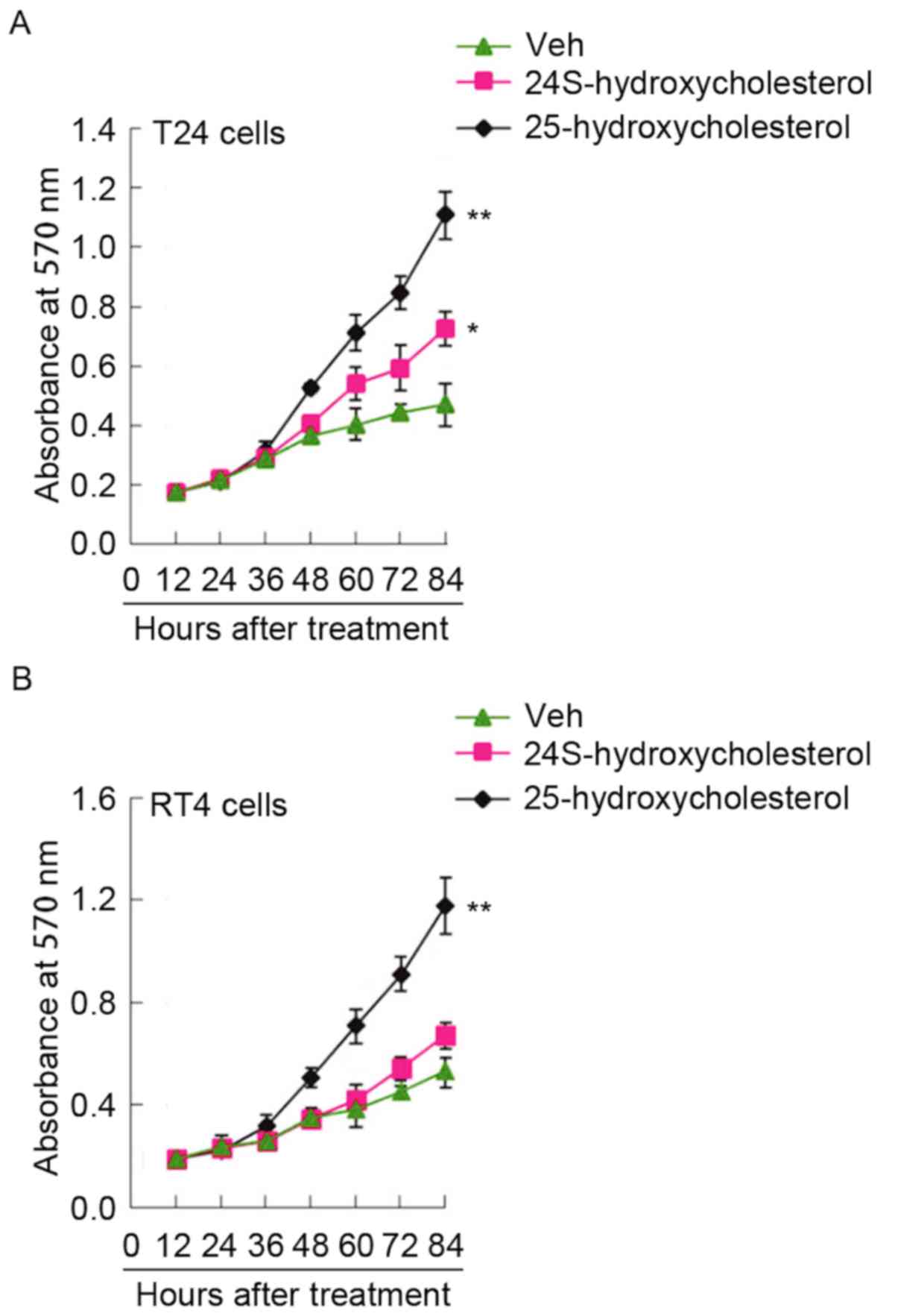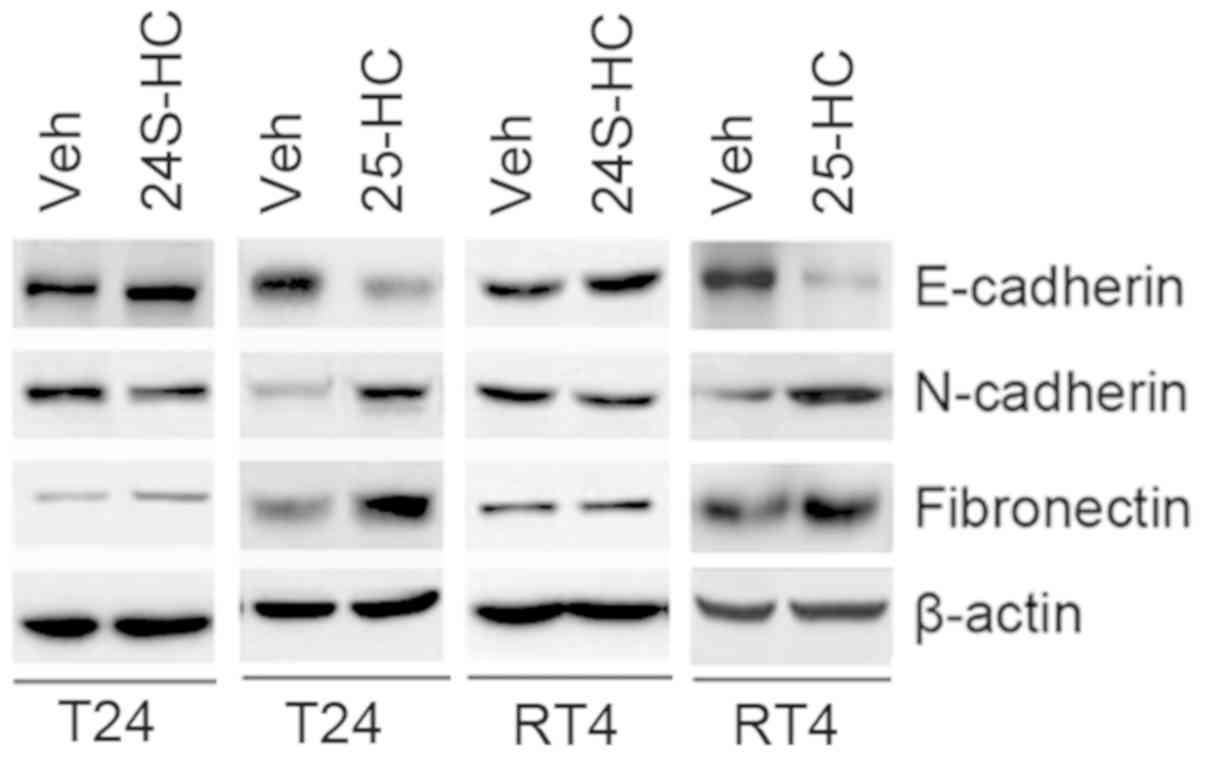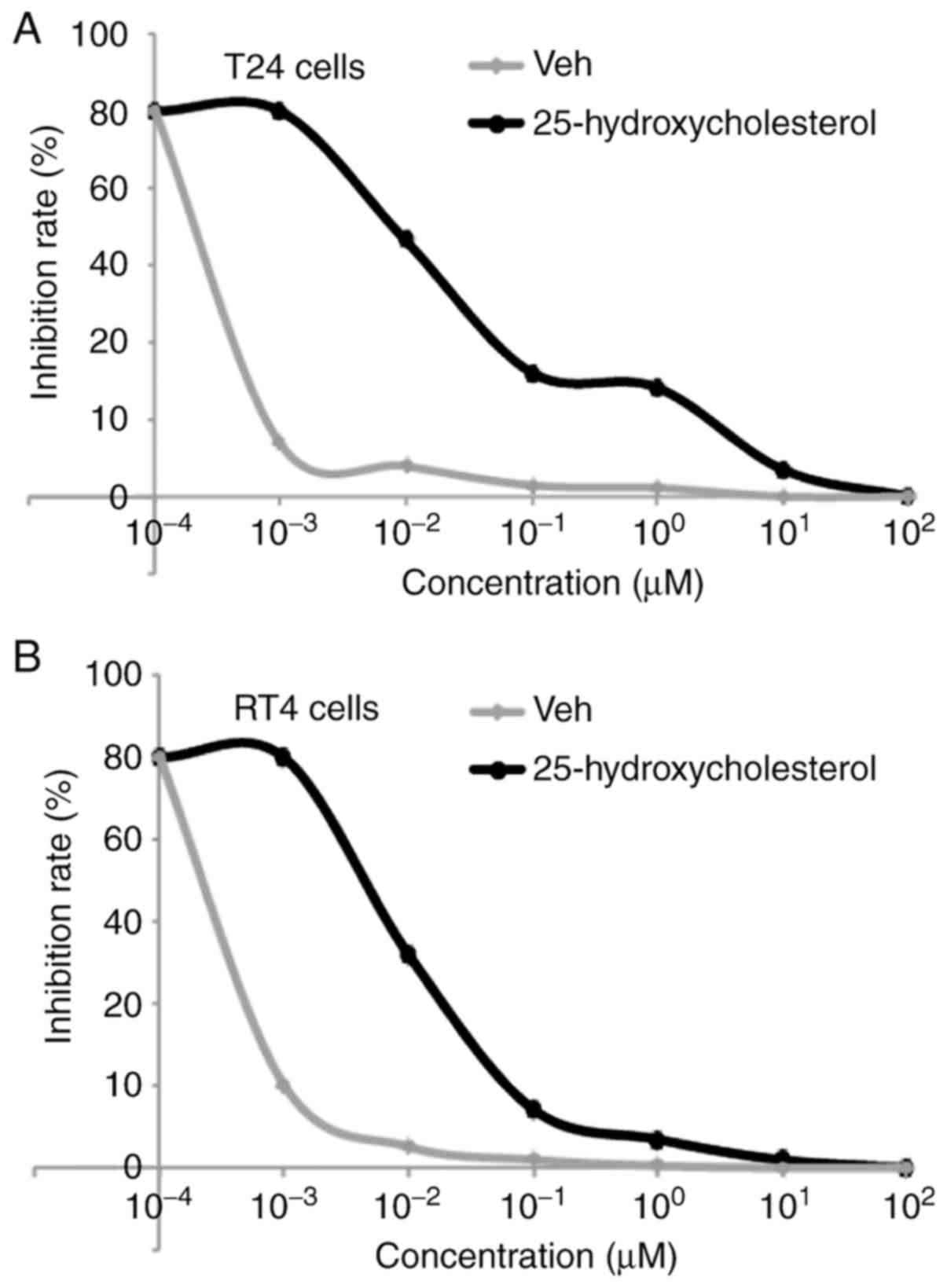|
1
|
Torre LA, Bray F, Siegel RL, Ferlay J,
Lortet-Tieulent J and Jemal A: Global cancer statistics, 2012. CA
Cancer J Clin. 65:87–108. 2015. View Article : Google Scholar : PubMed/NCBI
|
|
2
|
Antoni S, Ferlay J, Soerjomataram I, Znaor
A, Jemal A and Bray F: Bladder cancer incidence and mortality: A
global overview and recent trends. Eur Urol. 71:96–108. 2017.
View Article : Google Scholar : PubMed/NCBI
|
|
3
|
Fan Y, Shen B, Tan M, Mu X, Qin Y, Zhang F
and Liu Y: Long non-coding RNA UCA1 increases chemoresistance of
bladder cancer cells by regulating Wnt signaling. FEBS J.
281:1750–1758. 2014. View Article : Google Scholar : PubMed/NCBI
|
|
4
|
Lacey JV Jr, Devesa SS and Brinton LA:
Recent trends in breast cancer incidence and mortality. Environ Mol
Mutagen. 39:82–88. 2002. View
Article : Google Scholar : PubMed/NCBI
|
|
5
|
Sternberg CN, Donat SM, Bellmunt J,
Millikan RE, Stadler W, De Mulder P, Sherif A, von der Maase H,
Tsukamoto T and Soloway MS: Chemotherapy for bladder cancer:
Treatment guidelines for neoadjuvant chemotherapy, bladder
preservation, adjuvant chemotherapy, and metastatic cancer.
Urology. 69 (Suppl):62–79. 2007. View Article : Google Scholar : PubMed/NCBI
|
|
6
|
Li MZ, Lai DH, Zhao HB, Chen Z, Huang QX
and Situ J: SOCS3 overexpression enhances ADM resistance in bladder
cancer T24 cells. Eur Rev Med Pharmacol Sci. 21:3005–3011.
2017.PubMed/NCBI
|
|
7
|
Meng Q, Lei T and Zhang M, Zhao J, Zhao
X-H and Zhang M: Identification of proteins differentially
expressed in adriamycin-resistant (pumc-91/ADM) and parental
(pumc-91) human bladder cancer cell lines by proteome analysis. J
Cancer Res Clin Oncol. 139:509–519. 2013. View Article : Google Scholar : PubMed/NCBI
|
|
8
|
Tsuruo T, Iida H, Nojiri M, Tsukagoshi S
and Sakurai Y: Circumvention of vincristine and Adriamycin
resistance in vitro and in vivo by calcium influx blockers. Cancer
Res. 43:2905–2910. 1983.PubMed/NCBI
|
|
9
|
Li Q-Q, Xu J-D, Wang W-J, Cao XX, Chen Q,
Tang F, Chen ZQ, Liu XP and Xu ZD: Twist1-mediated
adriamycin-induced epithelial-mesenchymal transition relates to
multidrug resistance and invasive potential in breast cancer cells.
Clin Cancer Res. 15:2657–2665. 2009. View Article : Google Scholar : PubMed/NCBI
|
|
10
|
Smith LL: Cholesterol autoxidation
1981–1986. Chem Phys Lipids. 44:87–125. 1987. View Article : Google Scholar : PubMed/NCBI
|
|
11
|
Nelson ER, Wardell SE, Jasper JS, Park S,
Suchindran S, Howe MK, Carver NJ, Pillai RV, Sullivan PM, Sondhi V,
et al: 27-Hydroxycholesterol links hypercholesterolemia and breast
cancer pathophysiology. Science. 342:1094–1098. 2013. View Article : Google Scholar : PubMed/NCBI
|
|
12
|
Leoni V, Masterman T, Mousavi FS, Wretlind
B, Wahlund LO, Diczfalusy U, Hillert J and Björkhem I: Diagnostic
use of cerebral and extracerebral oxysterols. Clin Chem Lab Med.
42:186–191. 2004. View Article : Google Scholar : PubMed/NCBI
|
|
13
|
Saito Y and Noguchi N: 7-Hydroxycholestrol
as a possible biomarker of cellular lipid peroxidation: Difference
between cellular and plasma lipid peroxidation. Biochem Biophys Res
Commun. 446:741–744. 2014. View Article : Google Scholar : PubMed/NCBI
|
|
14
|
Hahn C, Reichel C and von Bergmann K:
Serum concentration of 7 alpha-hydroxycholesterol as an indicator
of bile acid synthesis in humans. J Lipid Res. 36:2059–2066.
1995.PubMed/NCBI
|
|
15
|
Kuroki S, Okamoto S, Naito T, Oda H,
Nagase S, Sakai H, Nawata H, Yamashita H, Chijiiwa K and Tanaka M:
Serum 7 α-hydroxycholesterol as a new parameter of liver function
in patients with chronic liver diseases. Hepatology. 22:1182–1187.
1995. View Article : Google Scholar : PubMed/NCBI
|
|
16
|
Koschack J, Lütjohann D, Schmidt-Samoa C
and Irle E: Serum 24S-hydroxycholesterol and hippocampal size in
middle-aged normal individuals. Neurobiol Aging. 30:898–902. 2009.
View Article : Google Scholar : PubMed/NCBI
|
|
17
|
Bandaru VVR and Haughey NJ: Quantitative
detection of free 24S-hydroxycholesterol, and 27-hydroxycholesterol
from human serum. BMC Neurosci. 15:1372014. View Article : Google Scholar : PubMed/NCBI
|
|
18
|
Zuliani G, Donnorso MP, Bosi C, Passaro A,
Dalla Nora E, Zurlo A, Bonetti F, Mozzi AF and Cortese C: Plasma
24S-hydroxycholesterol levels in elderly subjects with late onset
Alzheimer's disease or vascular dementia: A case-control study. BMC
Neurol. 11:1212011. View Article : Google Scholar : PubMed/NCBI
|
|
19
|
Leoni V, Long JD, Mills JA, Di Donato S
and Paulsen JS; PREDICT-HD study group, : Plasma
24S-hydroxycholesterol correlation with markers of Huntington
disease progression. Neurobiol Dis. 55:37–43. 2013. View Article : Google Scholar : PubMed/NCBI
|
|
20
|
Babiker A, Dzeletovic S, Wiklund B,
Pettersson N, Salonen J, Nyyssönen K, Eriksson M, Diczfalusy U and
Björkhem I: Patients with atherosclerosis may have increased
circulating levels of 27-hydroxycholesterol and cholestenoic acid.
Scand J Clin Lab Invest. 65:365–375. 2005. View Article : Google Scholar : PubMed/NCBI
|
|
21
|
Ziedén B, Kaminskas A, Kristenson M,
Kucinskienê Z, Vessby B, Olsson AG and Diczfalusy U: Increased
plasma 7 β-hydroxycholesterol concentrations in a population with a
high risk for cardiovascular disease. Arterioscler Thromb Vasc
Biol. 19:967–971. 1999. View Article : Google Scholar : PubMed/NCBI
|
|
22
|
Murakami H, Tamasawa N, Matsui J, Yasujima
M and Suda T: Plasma oxysterols and tocopherol in patients with
diabetes mellitus and hyperlipidemia. Lipids. 35:333–338. 2000.
View Article : Google Scholar : PubMed/NCBI
|
|
23
|
Linseisen J, Wolfram G and Miller AB:
Plasma 7β-hydroxycholesterol as a possible predictor of lung cancer
risk. Cancer Epidemiol Biomarkers Prev. 11:1630–1637.
2002.PubMed/NCBI
|
|
24
|
Prunet C, Petit JM, Ecarnot-Laubriet A,
Athias A, Miguet-Alfonsi C, Rohmer JF, Steinmetz E, Néel D, Gambert
P and Lizard G: High circulating levels of 7β- and
7α-hydroxycholesterol and presence of apoptotic and oxidative
markers in arterial lesions of normocholesterolemic atherosclerotic
patients undergoing endarterectomy. Pathol Biol (Paris). 54:22–32.
2006. View Article : Google Scholar : PubMed/NCBI
|
|
25
|
Noguchi N, Saito Y and Urano Y: Diverse
functions of 24(S)-hydroxycholesterol in the brain. Biochem Biophys
Res Commun. 446:692–696. 2014. View Article : Google Scholar : PubMed/NCBI
|
|
26
|
Lütjohann D, Papassotiropoulos A, Björkhem
I, Locatelli S, Bagli M, Oehring RD, Schlegel U, Jessen F, Rao ML,
von Bergmann K, et al: Plasma 24S-hydroxycholesterol
(cerebrosterol) is increased in Alzheimer and vascular demented
patients. J Lipid Res. 41:195–198. 2000.PubMed/NCBI
|
|
27
|
Kloudova A, Guengerich FP and Soucek P:
The Role of Oxysterols in Human Cancer. Trends Endocrinol Metab.
28:485–496. 2017. View Article : Google Scholar : PubMed/NCBI
|
|
28
|
Bergkvist A, Ljungqvist A and Moberger G:
Classification of bladder tumours based on the cellular pattern.
Preliminary report of a clinical-pathological study of 300 cases
with a minimum follow-up of eight years. Acta Chir Scand.
130:371–378. 1965.PubMed/NCBI
|
|
29
|
Fan Y, Shen B, Tan M, Mu X, Qin Y, Zhang F
and Liu Y: TGF-β-induced upregulation of malat1 promotes bladder
cancer metastasis by associating with suz12. Clin Cancer Res.
20:1531–1541. 2014. View Article : Google Scholar : PubMed/NCBI
|
|
30
|
Uicc T: Classification of malignant
tumours. Wiley-Liss; New York, NY: 2002
|
|
31
|
Huang L, Luo J, Cai Q, Pan Q, Zeng H, Guo
Z, Dong W, Huang J and Lin T: MicroRNA-125b suppresses the
development of bladder cancer by targeting E2F3. Int J Cancer.
128:1758–1769. 2011. View Article : Google Scholar : PubMed/NCBI
|
|
32
|
Yoshino H, Chiyomaru T, Enokida H,
Kawakami K, Tatarano S, Nishiyama K, Nohata N, Seki N and Nakagawa
M: The tumour-suppressive function of miR-1 and miR-133a targeting
TAGLN2 in bladder cancer. Br J Cancer. 104:808–818. 2011.
View Article : Google Scholar : PubMed/NCBI
|
|
33
|
Lu DL, Sookthai D, Le Cornet C, et al:
Reproducibility of serum oxysterols and lanosterol among
postmenopausal women: Results from EPIC-Heidelberg. Clin Biochem.
52:117–122. 2017. View Article : Google Scholar : PubMed/NCBI
|
|
34
|
Wu Q, Ishikawa T, Sirianni R, Tang H,
McDonald JG, Yuhanna IS, Thompson B, Girard L, Mineo C, Brekken RA,
et al: 27-Hydroxycholesterol promotes cell-autonomous, ER-positive
breast cancer growth. Cell Rep. 5:637–645. 2013. View Article : Google Scholar : PubMed/NCBI
|
|
35
|
Liao XH, Lu DL, Wang N, Liu LY, Wang Y, Li
YQ, Yan TB, Sun XG, Hu P and Zhang TC: Estrogen receptor α mediates
proliferation of breast cancer MCF-7 cells via a
p21/PCNA/E2F1-dependent pathway. FEBS J. 281:927–942. 2014.
View Article : Google Scholar : PubMed/NCBI
|
|
36
|
Varol N, Konac E and Bilen CY: Does
Wnt/β-catenin pathway contribute to the stability of DNMT1
expression in urological cancer cell lines? Exp Biol Med (Maywood).
240:624–630. 2015. View Article : Google Scholar : PubMed/NCBI
|
|
37
|
Metz CE: Basic principles of ROC analysis.
Semin Nucl Med. 8:283–298. 1978. View Article : Google Scholar : PubMed/NCBI
|
|
38
|
Zweig MH and Campbell G:
Receiver-operating characteristic (ROC) plots: A fundamental
evaluation tool in clinical medicine. Clin Chem. 39:561–577. 1993.
View Article : Google Scholar : PubMed/NCBI
|
|
39
|
Wallace DM, Bryan RT, Dunn JA, Begum G and
Bathers S; West Midlands Urological Research Group, : Delay and
survival in bladder cancer. BJU Int. 89:868–878. 2002. View Article : Google Scholar : PubMed/NCBI
|
|
40
|
Hu J, La Vecchia C, de Groh M, Negri E,
Morrison H and Mery L; Canadian Cancer Registries Epidemiology
Research Group, : Dietary cholesterol intake and cancer. Ann Oncol.
23:491–500. 2012. View Article : Google Scholar : PubMed/NCBI
|
|
41
|
Mouritsen OG and Bagatolli LA: Lipid
domains in model membranes: A brief historical perspective. Essays
Biochem. 57:1–19. 2015. View Article : Google Scholar : PubMed/NCBI
|
|
42
|
Chichili GR and Rodgers W:
Cytoskeleton-membrane interactions in membrane raft structure. Cell
Mol Life Sci. 66:2319–2328. 2009. View Article : Google Scholar : PubMed/NCBI
|
|
43
|
George KS and Wu S: Lipid raft: A floating
island of death or survival. Toxicol Appl Pharmacol. 259:311–319.
2012. View Article : Google Scholar : PubMed/NCBI
|
|
44
|
Hamm R, Chen Y-R, Seo E-J, Zeino M, Wu CF,
Müller R, Yang NS and Efferth T: Induction of cholesterol
biosynthesis by archazolid B in T24 bladder cancer cells. Biochem
Pharmacol. 91:18–30. 2014. View Article : Google Scholar : PubMed/NCBI
|
|
45
|
Bauman DR, Bitmansour AD, McDonald JG,
Thompson BM, Liang G and Russell DW: 25-Hydroxycholesterol secreted
by macrophages in response to Toll-like receptor activation
suppresses immunoglobulin A production. Proc Natl Acad Sci USA.
106:16764–16769. 2009. View Article : Google Scholar : PubMed/NCBI
|
|
46
|
Lappano R, Recchia AG, De Francesco EM,
Angelone T, Cerra MC, Picard D and Maggiolini M: The cholesterol
metabolite 25-hydroxycholesterol activates estrogen receptor
α-mediated signaling in cancer cells and in cardiomyocytes. PLoS
One. 6:e166312011. View Article : Google Scholar : PubMed/NCBI
|
|
47
|
McConkey DJ, Choi W, Marquis L, Martin F,
Williams MB, Shah J, Svatek R, Das A, Adam L, Kamat A, et al: Role
of epithelial-to-mesenchymal transition (EMT) in drug sensitivity
and metastasis in bladder cancer. Cancer Metastasis Rev.
28:335–344. 2009. View Article : Google Scholar : PubMed/NCBI
|
|
48
|
Sommers CL, Heckford SE, Skerker JM,
Worland P, Torri JA, Thompson EW, Byers SW and Gelmann EP: Loss of
epithelial markers and acquisition of vimentin expression in
adriamycin- and vinblastine-resistant human breast cancer cell
lines. Cancer Res. 52:5190–5197. 1992.PubMed/NCBI
|













